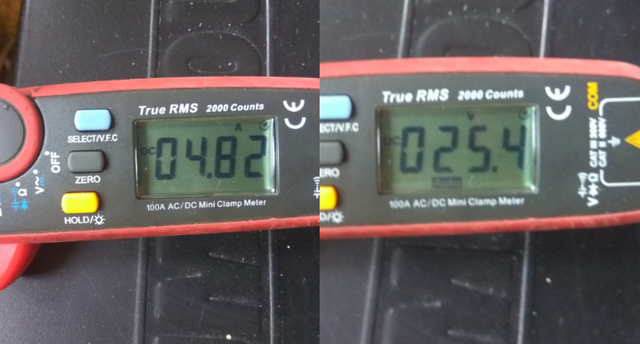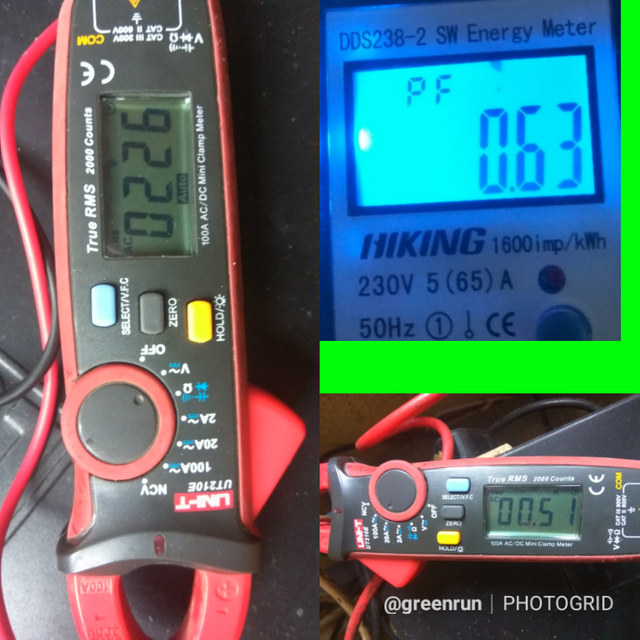The AC/DC Affair
Most often in our homes, we are surrounded by equipment that uses the direct current (DC) as their source of energy. The examples of such device include the cell phones, electric toothbrush, laptops, LED (light emitting diodes), etc. are all dc powered. Even though they may be plugged into an alternating mains supply, there is a rectifier inbuilt that transforms the AC to DC to make it work.

Image credits: from Pixabay Commons]
Though sometimes in the conversion of Ac to DC we may experience some losses. The other day, I showed my friend the loss in this conversion in his portable inverter setup that comprises two 12V 200AH battery and a 1.5KVA inverter system.

Here are the values:
Battery voltage= 25.4V
The direct current supply to the inverter = 4.82A
The Power= Current x Voltage = 4.82 x 25.4 = 122.428Watts

Moving on to the AC part, i.e the output supply of the inverter, which is now converted to alternating current, we have the following values:
Output load current= 0.51A
Output voltage= 226V AC @ 50Hz
Power factor= 0.63
Power factor is a ratio which shows the power that does useful work. So in this system, a pf of 0.63 shows that (1-0.63) or 37% of power is used up by either the capacitive or inductive element of the system leaving only 63% for actual work.
The real power or true power in an electric ac circuit is
P= VI cosφ
cosφ= power factor
Therefore the real power in the above setup is
P= 226 x 0.51x 0.63 = 72.6138 watts
If you compare the DC power of 122.428Watts with the AC power of 72.6138 watts, you would see that we have lost power in the conversion process.
The big question is why do we use alternating current instead of direct current? Why bother going through the troubles of converting DC to AC and converting it again to DC, in some instances, for devices such as our laptops, phones, LED bulbs, etc? Note, the load on the inverter was the same and the measurement on both the DC and AC values was carried out simultaneously.
Let us go back some years in the past. It was the 1880s and there exist two geniuses in their own right who together electrified the world. One was Thomas Edison, the famous inventor of the light bulb, and the other was Nikola Tesla. Edison was working on his direct current project after his invention of the direct current incandescent light bulb in 1879. Edison saw some of the limitations of DC and according to Tesla, offered a $50,000 payment to him if he could come up with ways to improve the limitation of DC, chief amongst which is its inability to transmit energy over long distances. Why was that a problem? At that time, the DC voltages of the Edison generators are low, in other to transmit it over long distances it would require an incredible massive size of wires to convey the electric power.
Tesla, a man who is said to think in three dimensions was able to come up with the solution to Edison's dilemma- the alternating current. When Tesla came back for his $50,000 reward, which should be six figure sum today did not get the promised amount, instead, Edison told Tesla it was a joke. The idea of an alternating current was one not welcomed by Edison. Tesla had to leave him in 1885 and then the "War of Currents" officially sets off. Tesla set up Tesla Electric Light and Manufacturing, a rival company to his former boss, Edison. He soon became a bigger threat to Edison's DC electric company when the big financier/industrialist George Westinghouse of the Westinghouse Electric and Manufacturing Company offered him financial help to Tesla.
Now we have seen a little of the history of these two kinds of electricity, we may now take a look at the features of the two.
The alternating current just as the name describes "alternates" or changes. The flow of charges (electrons) produces current. If the flow of current changes (reveres) direction as it flows, we have an alternating current.

Image credits: Booyabazooka Wikipedia Public Domain, Link]
The frequency of an alternating current is the number of complete cycles (from 0 to 360) that the alternating waveform makes in a second. The frequency of an alternating current is the number of complete cycles (from 0 to 360) that the alternating waveform makes in a second. So if the alternating waveform makes ten complete cycles (we have one complete cycle in the diagram on the right) the alternating current frequency is 10 Hertz. In Nigeria, the frequency of operation is the same as the European countries; at 50 Hertz or 50 cycles per second at 220-230 voltage.
The waveform of an alternating current is not usually sinusoidal as depicted in the diagram above. It may be in other waveforms such as square, triangle, or sawtooth in shape.

Image credits: By Omegatron [CC BY-SA 3.0 or GFDL], from Wikimedia Commons]
If you observe the various waveforms there is a certain similarity in all. First, the current moves from zero until it reach the maximum positive value, then it retraces (falls) to zero again and enters the negative part of the journey. That also gets to the maximum value and returns to zero completing a full cycle.

Image credits: By FatmirJashari [CC BY-SA 3.0 ], from Wikimedia Commons]
Direct current, on the other hand, is unidirectional, i.e it does not alternate but rather it flows in one direction, either in forward or in the backward direction. It can only flow in a particular direction at a particular time.
The direct current is not the electricity of choice in transmission as it is not economical when employed in short distances. It only becomes economical when the minimum transmission distance is at least 400KM, for overhead transmission.
In 2016, a 12GW 3000KM went to ABB to build in China an ultra high direct current voltage (1100KV DC) which sets the record for the longest distance transmission. You can watch the video of the 1100KV UHVDC transformer and see the ABB engineers talk about the successful testing here.
But the major reason, alternating current apparently have a huge popularity is because of the ease of change of both voltage and current via the use of a transformer at a very cheap rate.
For instance, some generating stations in Nigeria has 10.5KV of the voltage at the generator's terminal, this voltage is stepped up to 330KV for transmission to neighbouring states. On getting there it is stepped down to 132/33KV. This voltage is further stepped down again to 11KV/ 0.415KV (phase to phase) or 0.230KV line-to-neutral voltage.
In the house, this 230V undergoes further changes, via various transformers in our electronics, home appliances, etc.
The AC, because of the above is more preferred to DC in use around the home and in shorter distance transmission.
References
- Powerfactor
- Nikola Tesla vs. Thomas Edison: Who Was the Better Inventor?
- Edison vs. Westinghouse: A Shocking Rivalry
- High-voltage direct current
- ABB achieves breakthrough with world’s most powerful HVDC transformer
If you write STEM (Science, Technology, Engineering, and Mathematics) related posts, consider joining #steemSTEM on discord here. If from Nigeria, there may be need to include the #stemng tag in your post. You can visit this blog by @stemng for more details. You can also check this blog post by @steemstem here and this guidelines here for help on how to be a member of @steemstem. Please also check this blog post from @steemstem on proper use of images devoid of copyright issues here
Would you like to delegate to the @steemstem? Here is a link below
50 SP | 100SP | 500SP | 1,000SP | 5,000SP | 10,000SP | 50,000SP

interesting phenomenon occurs during the transmission from the generating station till it reaches our home thanks for sharing all about it
The main reason why dc cannot be used is that it cannot be stepped up as Ac using transformers.
When transmitting either ac or dc, there exist losses(dc losses is higher though in short distance). Assuming the consumers end has been reached and the remaining voltage is low, we can use transformer to boost the low voltage if it is ac; but if it is dc, nothing can be done
Well done @greenrun
Please can you reread your reply and make some corrections, on the first part of your comment, as I cannot clearly understand what you mean.
DC losses is higher in short distance transmission. At longer distance, DC beats AC. Thank you.
Corrected
I had 1% battery remaining after reading this post last night, so i typed the comment quickly.
A DC converter station can be step up DC to a very high voltage, up to 1100KV as evidenced by the new ultra-high voltage direct current (UHVDC) transmission using Siemens Transformer. The only issue is that DC is not economical for short distance transmission,i.e. distances shorter than 600KM, at distances greater than 600KM, the AC losses increases so much that a DC setup becomes more efficient.
Ooooh
That should be an improvement in technology
I know from farday's law, flux must exist for a transformer to work
And dc got no flux
We still use electrical theory and I'm told there are no institutions on Earth that have mastered or proved how electricity actually works.(or publicly anyway) I recommend this video which explains the whole history and mystery of it.
Thanks for sharing :-)
I'm going to need loads of data (I'm on a metered prepaid connection) to watch the video :) Thank you.
As always nice post... Thanks for teaching me something!
Thank you too.
😀😀😀
Hi Sir Green
Wow. This is very interesting I must confess. Particularly intriguing is the short arithmetics explaining how power is lost in converting dc to ac current.
That was an expensive joke from Edison, men of this era would have taken him to court for breach of agreement.
Do have a great day.
@sciencetech
STEM contributor
There was no written agreement, so Edison can't be held liable for a breach of it.
Well, Tesla tried to show him who'd have the last laugh :)
Sure. You are right
This post has been voted on by the steemstem curation team and voting trail.
There is more to SteemSTEM than just writing posts, check here for some more tips on being a community member. You can also join our discord here to get to know the rest of the community!
I am wowed by the presentation of this post.
Sometime ago i wrote on the war of currents. I love the way you simplified the term "power factor". Even a novice would relate.
Also till now, i didnt know gere was something such as UHVDC...
Always a new thing to learn on your blog
All in all... I say Kudos!!!
You are far too kind. Thanks a lot :)
I've never heard of the Ultra High Voltage DC before now .
I've been thinking; if a DC can be stepped up to a high voltage, but now my questions have been answered in this post.
Thanks for sharing buddy
Hi @greenrun!
Your post was upvoted by utopian.io in cooperation with steemstem - supporting knowledge, innovation and technological advancement on the Steem Blockchain.
Contribute to Open Source with utopian.io
Learn how to contribute on our website and join the new open source economy.
Want to chat? Join the Utopian Community on Discord https://discord.gg/h52nFrV
AC or DC, each has its strong points and weak points depending on the case in concern. Well regardless of which is preferred in one case or the other, electricity in general will remain man's greatest invention.
By the way, your analyses are always spot on.
Well done sir.